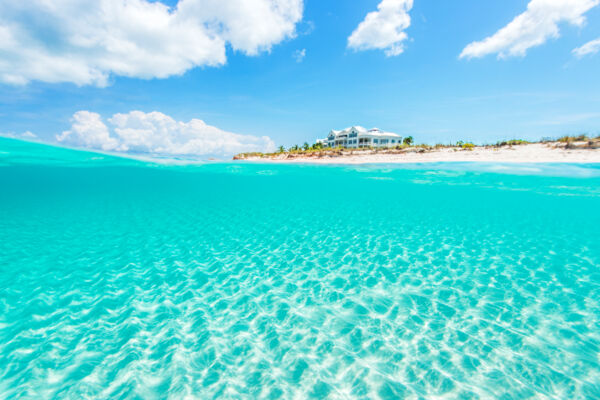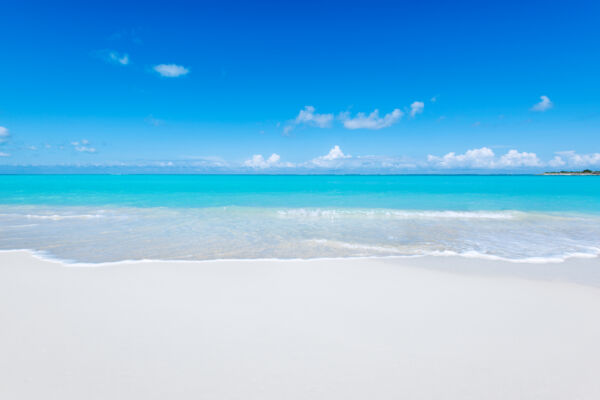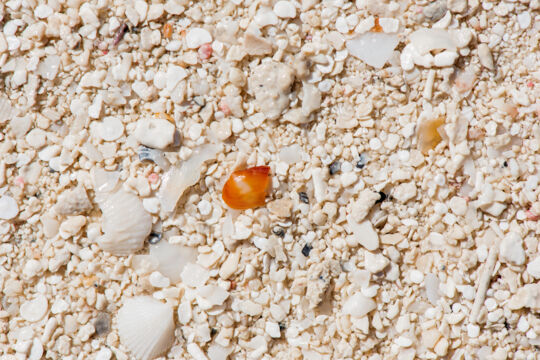Why the Turks and Caicos Have The Best Beaches in the World

The Turks and Caicos is recognized as having some of the best beaches in the world and a visit to one of the popular coastlines will convince nearly everyone of the fact.
There are several causes that account for the white sand and spectacular turquoise water.
You may also be interested in Beaches of the Turks and Caicos, Beaches of Providenciales, Beaches of Grand Turk, and the world-famous Grace Bay Beach.
The Light and Soft Sand
The defining characteristic of a beach is its sand. The Turks and Caicos beaches almost without exception have shell and coral-origin sand. This type of sand is formed from the naturally broken down particles of seashells and hard corals, and the result is breathtaking bright white sand with touches of pink and peach hues.
Another factor is the lack of hard rock origin or dark-colored sand and gravel, found in other Caribbean countries. The Turks and Caicos Islands and their subterranean foundation is primarily limestone. Except for very thin outer layers exposed to the elements, this limestone tends to be quite soft and white. Once this rock begins to break up into smaller pieces, it rapidly decomposes into sand and dust and remains a bright white throughout the process. Because of this, sand on the beaches and ocean floor has almost no gravel and is consistent and naturally light-colored.
As seen throughout much of the world, beaches with hard rock origin sand tend to have denser, smaller, and more uniform sand grains, and these grains naturally pack together tighter when damp or wet. The larger and irregular grains of the Turks and Caicos sand allows for much greater gaps in between grains which leads to the fluffiness we all love.
The size of the sand grains does vary by beach throughout the country, and the beaches of Providenciales are perfect for highlighting this. On the west coasts of Malcolm’s Road Beach and the Northwest Point National Park, the beaches are often very close to the barrier reef and consequently, the sand is quite coarse with recognizable shell fragments. However, due to being formed from the weathered sand of the extensive Caicos Banks, the south coast beaches of Long Bay Beach, Taylor Bay, and Sapodilla Bay have very fine sand grains. The sand of Grace Bay Beach, The Bight Beach, and Leeward Beach comes in between these two extremes.
The Brilliant and Colorful Water

The Turks and Caicos has some incredibly beautiful ocean water and there are several factors behind this.
The vivid blues of the deeper water is mainly due to the fact that the longer and warmer wavelength colors (reds, oranges, yellows) are filtered out and scattered before the short blue wave lengths. This results in the deep blues common to all clean and deep ocean water.
The azures, aquas, and turquoises of the shallower depths are what really contribute to the unique Turks and Caicos water and are caused by light reflecting off the white sandy bottoms and off of fine white sand particles that are suspended in the ocean. This is especially apparent in the brilliant Chalk Sound National Park on Providenciales where white limestone silt reflects amazing turquoise hues.
Although less common, phytoplankton is the main cause of some of the bottle greens seen in the sheltered wetlands and in patches in the Caicos Banks.
Last but not least, corals can add quite a bit of color in some areas. Bright yellow sea fans, reddish sponges, and green hard coral all add to the spectrum.
The normal tide shifts cause differing water depths in the channels and varying amounts of suspended particle densities, which paint spectacular landscapes. No places in the Turks and Caicos display this better than the channels dividing the small cays between Middle Caicos and South Caicos.
When many people see photos of the beaches and lagoons of the Turks and Caicos, they believe that the water in the images must have been edited. In actuality, the ocean is typically far more vivid when seen in person.
The Best Way to Discover Our Marine Environment
Our beaches and water define our tourism product, and one of the best things to do on vacation is to discover some of the spectacular marine locations in our archipelago. For guests staying on Providenciales, some sites such as Grace Bay Beach and Chalk Sound National Park, are easy to get to. Other amazing sites, including the West Caicos Marine National Park, the sandbars at Fort George Cay and Pine Cay, and the beaches and lagoon at Half Moon Bay, Little Water Cay, and Water Cay are only accessible by boat or watercraft, and a private charter is our recommended way to visit.
Further afield are some more breathtaking uninhabited cays and coastal areas, including Long Cay near South Caicos, and Little Ambergris Cay.
Beachfront Hotels and Resorts
As expected, the first hotels on Providenciales were developed on the best parts of Grace Bay Beach, with the widest part of natural beach. This was the case with Club Med Turkoise, the first main resort and all-inclusive, and the Grace Bay Club, the first luxury property in the Turks and Caicos.






